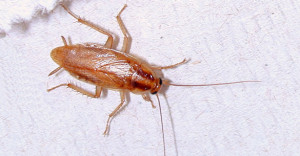You may not have cockroaches in your home. But cockroaches remain one of the most important indoor pests of homes, especially in multifamily housing. If you do have occasional problems with the small kitchen cockroaches, known as German cockroaches, there is good news, and it’s as close as the insecticide shelf in your grocery store.
A story
Before starting graduate school in entomology I worked as a pest control technician out of college. One of my accounts was a sprawling, multi-story public housing complex. These visits were frustrating to me, because of the difficulty (impossibility) of putting much of a dent in the well entrenched German cockroach population that scurried back and forth among these apartments.

German cockroaches are some of the smallest cockroach pests. Their ability to reproduce quickly, however, makes them one of the most difficult to control indoor pests.
One of my visits, however, was the home of a single mom. It was a short encounter, and I’m not sure I ever saw her again; but the mother’s gratitude for my efforts to battle the cockroaches plaguing her and her daughter made an impression on me. The apartment was uncluttered and very clean. It was obvious she was doing her part to keep cockroaches at bay–something that made my job a lot easier and more effective. Despite the feeling that I wasn’t putting much of a dent in the overall cockroach problem in those apartments, I went home that night feeling a little better about my job in pest control.
What’s changed
Two major changes have occurred in cockroach control since the early 1980s. First, the scientific community has learned a lot more about the health impacts of cockroaches. Besides being unsanitary and capable of spreading disease pathogens, we now have solid evidence to show that cockroaches are major contributors to asthma illness, especially among children living in infested homes. Indeed, the feces and shed exoskeletons of cockroaches have proved to be among the most important indoor asthma causes we know of. Children who grow up in cockroach infested apartments have higher rates of asthma, more missed school days, and more doctor visits than do their more affluent classmates from cockroach-free homes.
Second, with the discovery of effective baits, we have much better tools for cockroach control today. The insecticides available to me in 1980 were mostly residual sprays and dusts that had to be applied directly to cockroach hiding places. If counter-tops were not cleared and covered, or cupboards not emptied before I arrived, there was little I could safely do with my carbamate and organophosphate sprays and dusts. In addition, many of these sprays were repellent to cockroaches, something that I learned later in grad school greatly reduces their effectiveness against insecticide-avoiding cockroaches.
Today’s professional and over-the-counter insecticides are safer and vastly superior to the old insecticides. Containerized and gel baits, in particular, have revolutionized our ability to manage cockroaches. Although sanitation is still important for cockroach IPM, baits have shown an ability to suppress cockroach numbers even in cluttered and not-so-clean homes.
A number of studies have shown over the past 20 years that cockroach control and sanitation efforts could significantly reduce the quantity of cockroach allergens in apartments. Indeed, the National Asthma Education and Prevention Program recommends reducing cockroach exposure as a critical step to take in reducing asthma risk.
New research
A new study in the Journal of Allergy and Clinical Immunology out this week is the first to show that cockroach baiting by itself can result in measurable improvements in the health of children. The researchers looked at the apartments of 102 children (aged 5-17 years), all of whose homes had some level of cockroach infestation. Half of the children were assigned to homes that would be treated by researchers with cockroach baits, and half of the homes were left untreated by researchers. All of the homes were sampled for cockroaches using Victor® Roach Pheromone Traps, and health indicators were measured for all the children (such as number of school days missed, medication used, days of wheezing, number of nights where children woke up, etc.).

Cockroach baits come in gel form (shown) or in plastic stations. They should be placed in crevices or as close to suspected cockroach hiding places as possible.
Treatment of homes consisted of placing either Maxforce® FC Magnum, or Advion® cockroach bait gels in areas with evidence of active cockroach infestation. Those who put out the bait were not even trained professionals. Instead, research staffers were instructed to place baits in the back corners of kitchen cabinets, behind kitchen appliances, and inside bathroom vanities. No other control methods were used.
The median cockroach numbers were significantly lower in treated homes vs. untreated. By the end of the study none of the baited homes had evidence of cockroach activity, compared to a 20% infestation rate of the untreated homes.
Interesting to me was that after the study began cockroach numbers in the untreated homes went from 100% infested to only 20% infested. The authors of the study attributed the drop in untreated homes to “study effects”. People whose homes did not get treated, but were being monitored for cockroaches, took extra pains to clean up before the research team arrived, and they conducted additional cockroach control on their own, apart from insecticide baits applied by the researchers. This lead to an almost 85% reduction in trapped cockroach numbers in the control homes.
So it’s even more remarkable that, despite the cockroach reductions in homes not receiving bait treatment, researchers still noted significantly better cockroach suppression with bait-treated homes and significant improvements in children’s health. In treated homes, for example, children had 47 fewer days a year with asthma symptoms compared to homes that were not treated with baits. Children in treated homes also had improved lung function and significantly fewer doctor visits compared to untreated homes, despite the relatively small sample size and relatively low cockroach levels in untreated homes.
When I consider how far cockroach control has come since my days with a steel pump sprayer and smelly sprays, these results are truly amazing.
So here’s the good news for anyone living with cockroaches. A trip to your local grocery or garden center, or a visit to one of the many online DIY pest control businesses, can secure cockroach baits that are far better than anything I had 35 years ago. For more information about selecting and using cockroach control products, see our Extension factsheet on cockroach biology and control at https://extensionentomology.tamu.edu/wp-content/uploads/sites/3/2016/07/E-359-Cockroach-biology-and-management-2012.pdf